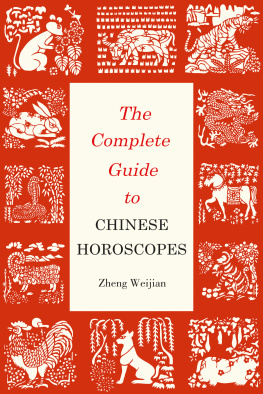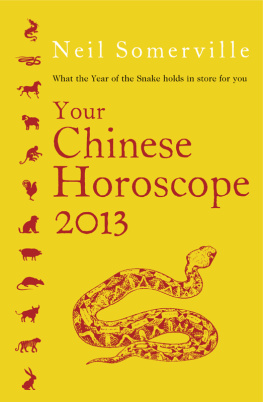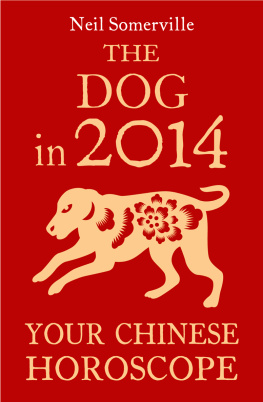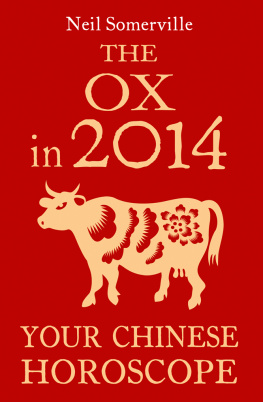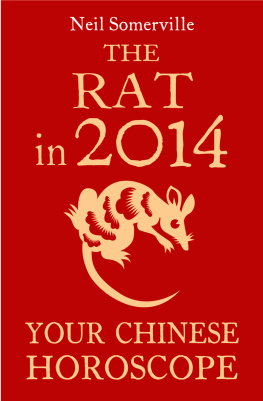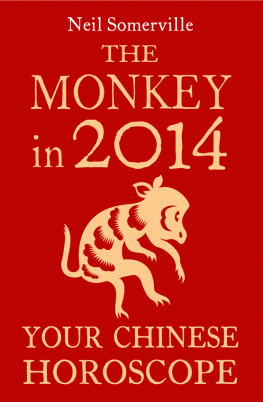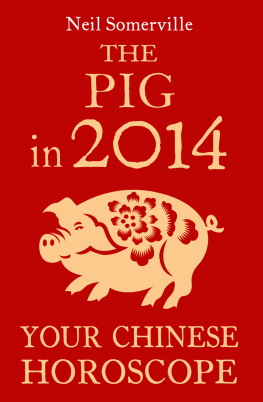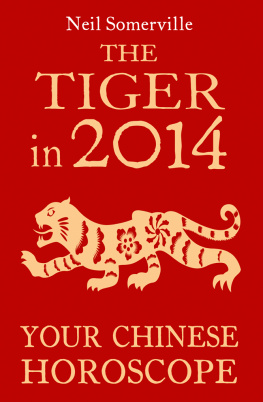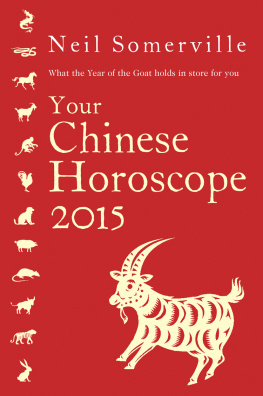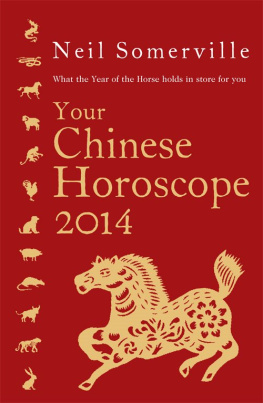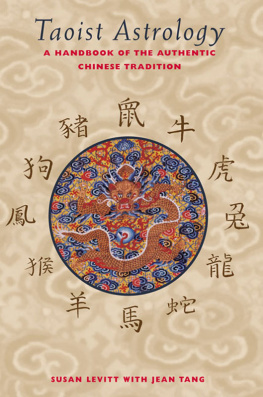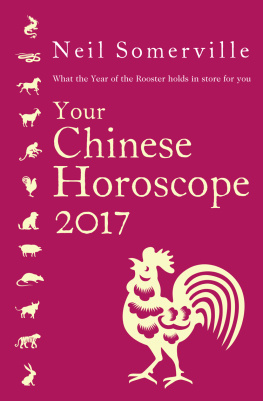The Complete Guide to
CHINESE HOROSCOPES
Zheng Weijian
Translated by Cao Jianxin
Better Link Press
Copyright 2016 Shanghai Press and Publishing Development Co., Ltd.
All rights reserved. Unauthorized reproduction, in any manner, is prohibited.
This book is edited and designed by the Editorial Committee of Cultural China series.
Text: Zheng Weijian
Translation: Cao Jianxin
Designer: Wang Wei
Photos: Getty Images, Quanjing, Cultural Relics Press
Copy Editor: Susan Luu Xiang
Editor: Wu Yuezhou
Editorial Director: Zhang Yicong
Senior Consultants: Sun Yong, Wu Ying, Yang Xinci
Managing Director and Publisher: Wang Youbu
ISBN: 978-1-60220-171-2
Address any comments about The Complete Guide to Chinese Horoscopes to:
Better Link Press
99 Park Ave
New York, NY 10016
USA
or
Shanghai Press and Publishing Development Co., Ltd.
F 7 Donghu Road, Shanghai, China (200031)
Email:
Printed in China by Shenzhen Donnelley Printing Co., Ltd.
5 7 9 10 8 6 4
The content in this book is provided for informational and entertainment purposes only.
Introduction
W estern astrology practices divination through the observation of the movements of planets. This has been a part of the popular culture in the west since the beginning of time; when men first glanced upwards to the evening sky at the vast constellation of stars. Likewise, the 12 symbolic animal signs (the Chinese zodiac animals) that represent the year of a persons birth are very much a part of the Chinese culture as well as in other Asian countries. Where Western astrology can predict personality traits, career paths, marriage and the attainment of wealth from planetary shifts, Eastern people can also make a wide range of accurate predictions using animal signs.
Fundamentally speaking, the animal signs of the east have a close association with Western astrology. For instance, the Rat corresponds to Aquarius. The Ox corresponds to Capricorn. The Tiger corresponds to Sagittarius. The Rabbit corresponds to Scorpio. The parameters that are used to process an individuals personal animal sign is a bit more complex than the parameters used in Western astrology, because the animal signs also take into consideration the hour, the day, the month, and the year of ones birth.
The success of each person depends on their own unique path in life and, in addition to great differences in personalities, there are a diversity of environments to consider. However, those who enjoy success seem to have similar traits that are associated with the animal signs, and also share a combination of mental acumen, initiative, respect for others, their role in society and harmonious relationship with the environment.
The twelve animals signs are inspired by eleven animals of the earth, the Rat, the Ox, the Tiger, the Rabbit, the Snake, the Horse, the Sheep, the Monkey, the Rooster, the Dog and the Pig and the Dragon, the only ancient mystical being. As extremely important elements in folk culture, these twelve animals are well known among all Chinese people. Though their exact origins cannot be confirmed, they have been passed on from generation to generation due to their popularity, convenience and amusement. They are precious heritages of practical values left by people in ancient times.
The common belief is that a persons personality and luck are more or less associated with the habits, appearance, and movements of a particular animal sign, because sheng () means birth and xiao () means similarity. Shengxiao, i.e. animal signs symbolize similarity between a person and a certain animal. Linking human wisdom, strength, courage, health, and charm with certain animals demonstrates a strong awareness of the influence of nature in the cycle of life that has contributed to a civilizations longevity for thousands of years.
There are various myths and legends about the origin of the twelve animal signs. The most popular legend tale is of the Yellow Emperor, who wanted twelve different kinds of animals to be on duty in Heaven at all times. He devised a competition where the Rat, the Ox, the Tiger, and the other nine animals emerged as victors. One myth attributes the origin of the twelve animal signs to a primitive society that worshipped individual animal totems belonging to specific clans. Lastly, astronomy has always been a big influence; the twenty-eight constellations in the sky corresponds to twelve periods of time. Each constellation is named after an animal. A particular commonly seen animal on duty in each period of time was then chosen to represent a certain year.
Since the time of Emperor Shun, China has been applying annals marked by a combination of the ten symbols of Heavenly Stems with the twelve symbols of Earthly Branches. The ten symbols of Heavenly Stems refer to Jia (), Yi (), Bing (), Ding (), Wu (), Ji (), Geng (), Xin (), Ren (), and Gui (). The twelve symbols of Earthly Branches refer to Zi (), Chou (), Yin (), Mao (), Chen (), Si (), Wu (), Wei (), Shen (), You (), Xu (), and Hai (). There are sixty groups that are set analogically in order with a combination of the ten symbols of Heavenly Stems with the twelve symbols of Earthly Branches, such as Jia with Zi (), Yi with Chou ( ), and Bing with Yin ( ). These sixty groups are coupled with the year and there is a repeat once every sixty years. If coupled with the month, there is a repeat once every sixty months (five years). If coupled with the day, there is a repeat once every sixty days. If coupled with the hour, there is a repeat once every sixty periods of time (i.e. a period of time stands for two hours). Such repeating goes on all the time. The year, the month, the day, and the hour are respectively marked by annals of Heavenly Stems and Earthly Branches. People in ancient times also used the twelve animals to match the twelve symbols of Earthly Branches. Zi stands for the Rat and Chou stands for the Ox, etc., with the rest of them matched analogically.
The earliest written record about the twelve animal signs can be seen in the Book of Song (Shi Jing), the first poetry collection in the world. At what instance was the twelve animal signs mentioned? According to historical data, such mention took place in the Han Dynasty (206 BC220), based on On BalanceMaterials, a noted work by Wang Chong in the Eastern Han Dynasty (25220). As it goes: Yin stands for the Wood and the animal concerned is the Tiger. Xu stands for the Earth and the animal concerned is the Dog Wu stands for the Horse. Zi stands for the Rat. You stands for the Rooster. Mao stands for the Rabbit Hai stands for the Pig. Wei stands for the Sheep. Chou stands for the Ox Si stands for the Snake. Shen stands for the Monkey.
The above-mentioned quotation only includes 11 kinds of animals, with the absence of the Dragon. However, with The Wu Kingdom lies in Chen positioned at the Dragon written in the Spring and Autumn of Wu Yue by Zhao Ye in the Eastern Han Dynasty, the Chen Dragon came into being, thus bringing about the twelve animal signs as we know it today.
The twelve animal signs were widely used in the Northern and Southern Dynasties (420598). A letter from Yu Wenhus mother to him that was recorded in History of Northern DynastyBiography of Yu Wenhu reads: Two of your brothers were born at Wuchuan Town. According to the twelve animal signs, the elder one belongs to the Rat, the younger one belongs to the Rabbit, and you belong to the Snake.
Next page
